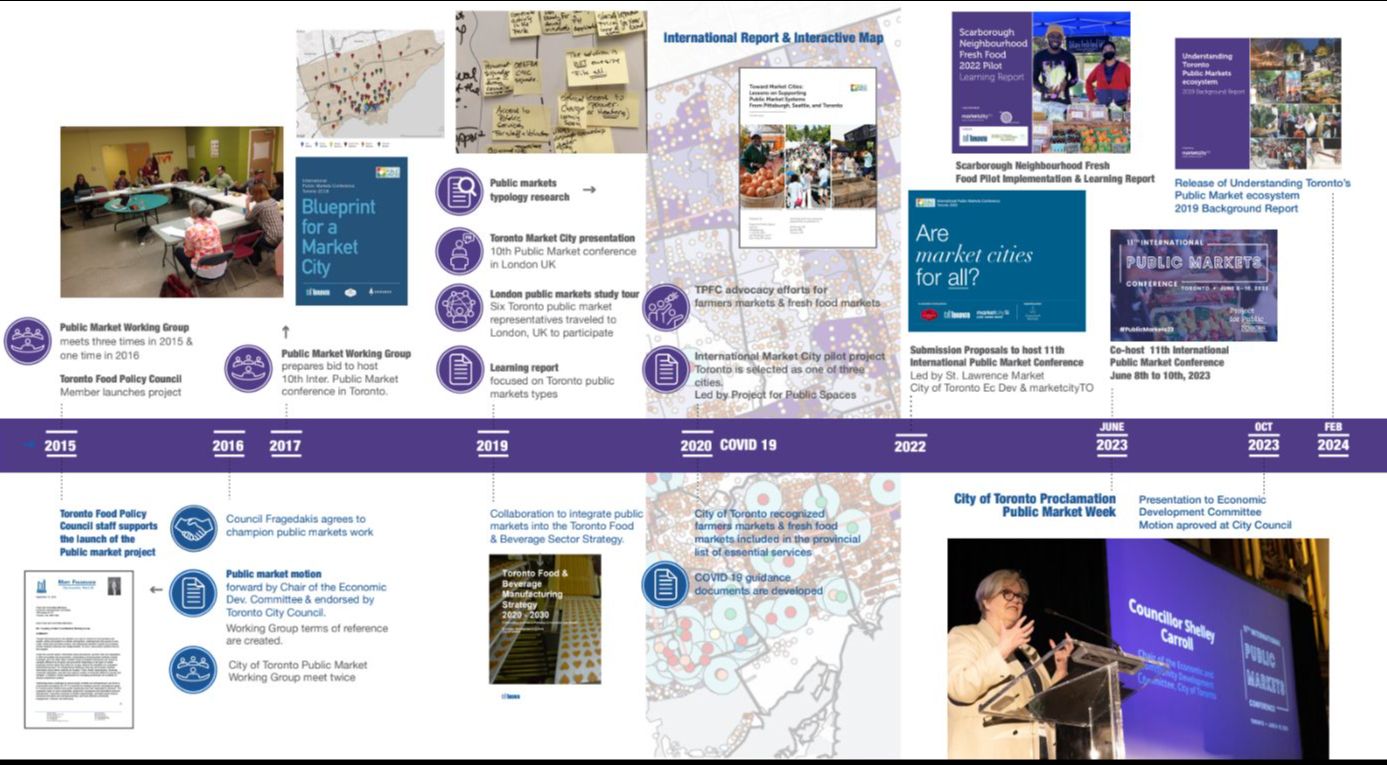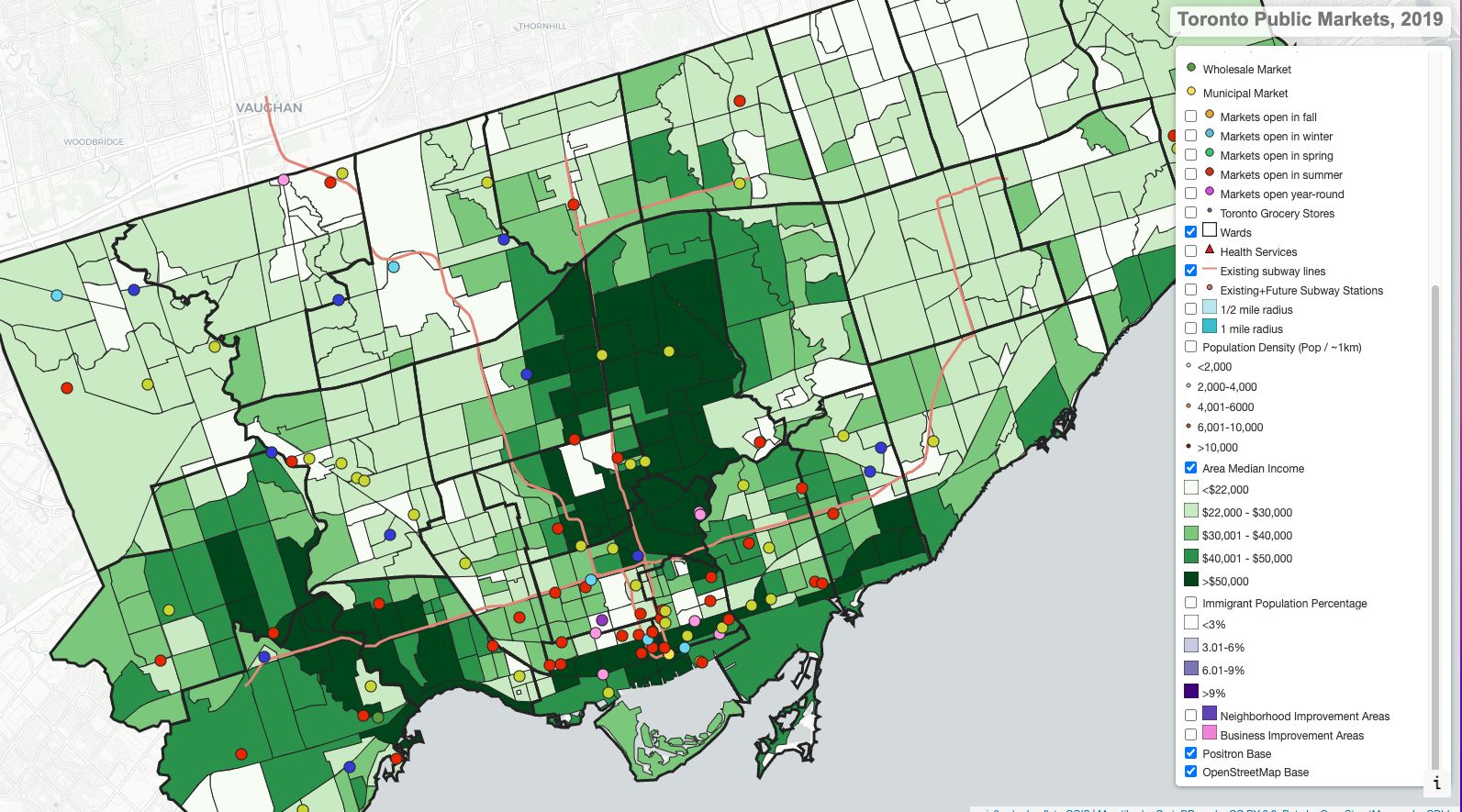
Toronto has more than 130 Public Markets (PM) built from the ground up by strong community champions or key anchor organizations. They embrace diverse models, audiences and mandates that respond to residents’ needs and often deliver programs that address municipal gaps.
Though long-treasured by city-dwellers as a way to connect to local growers and urban entrepreneurs while surrounded by a festive atmosphere, markets provide entertainment and access to arts, crafts, street food and fresh produce. Still, the widespread benefits of public markets need to be discovered and appreciated. As such, many public markets exist on the margins.
From the St. Lawrence market, the only municipal market, to seasonal Farmers and Flea markets, to semi-permanent markets like Market 707 or the Ontario Food Terminal (Canada’s only wholesale market), these public markets are drivers of our local economy. These forms of retail are part of the mid-size distribution infrastructure that enables regional supply, inclusive and diverse economies and promote social connections at a neighbourhood level.
> Increase education on the role of the Public Market in city building.
> Celebrate Public Markets and the people & businesses involved.
> Promote the various forms of Public Markets our city.

This report aggregates public market baseline information from 2015 to 2019, making it an essential resource for councillors, city staff, regulators, market managers, operators, vendors, entrepreneurs, academics, and senior levels of government. Furthermore, this would interest people and organizations working in social justice, food systems transformation and inclusive economic development.
More importantly, this document reports back to the Economic Development Committee (current Economic & Community Development Committee) on the barriers and opportunities for the further development of public markets in the City of Toronto and can be used to begin the work required to catalyze action to transform Toronto into a world-class Market City.
We hope you download the report to learn more about the Toronto Public Market ecosystem and use it as a resource to gain the information you need to advocate for your market and community.
Download report here
For comments or questions, reach out to Marina Queirolo at mqueirolo@marketcityto.org

We have created the first Winter Market Map! Check these places to visit and shop locally from November to May.
As the cold and short winter months approach, it's essential to highlight the upcoming Winter and Holiday Markets. These markets play a crucial role in bringing vendors and customers together, especially for those experiencing social isolation during the cold and short winter days. However, we know that making these markets successful can be challenging. Often, customers don't show up, so sales are low, leaving managers and vendors exhausted, especially after the busy outdoor season and no winter rest.
Please help us spread the word and share information about these markets with your followers and networks. If your market or special holiday event is not included in our map, please complete this Google form so we can include it.
Let's work together to support our local communities during the winter season!

The International Market Cities Program began working with the Toronto Food Policy Council and Marina Queirolo, lead for the public market initiative, along with the two other pilot project cities: Pittsburgh, PA and Seattle, WA, in March 2020, at the beginning of the COVID-19 crisis.
In light of the pandemic, the Toronto partners' top priority was advocating for farmers' markets and fresh food markets to be declared essential services by the City.
During that time, thanks to the support of the University of Toronto Scarborough Feeding City Lab, we were able to collect baseline data on the public market system through meetings and interviews with key players in local food policy; surveying of markets; and mapping the public markets along with other data layers including wards, the subway system, population density, walking distance to markets, priority neighbourhood and business improvement areas, and grocery stores to identify gaps and opportunities for public markets. This 2019 data formed the basis for the first International report and public market interactive map,
Thanks, Glen Miller and Spacing Magazine, for writing about this important issue! We look forward to further collaboration and helping more planners, decision-makers and residents understand why we must support public markets.
Photo: Farmers Market at the Ontario Food Terminal, 400 farmers market tenants sell directly, and another 1,500 Ontario farmers sell indirectly through warehouse tenants. There are approximately 3,500 Ontario fruit and produce farmers in Ontario, 45% of which rely on the Ontario Food Terminal to sell all or part of their produce to independent green grocers and groceries.
http:/spacing.ca/toronto/2023/05/22/filling-in-the-missing-middle-for-food-retailing/
We work with Toronto’s intrepid market managers, vendors, city staff and policy-makers to activate the power of markets. Get in touch ->

Marina Queirolo
Public markets & food systems specialist
mqueirolo@marketcityto.org